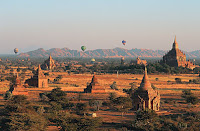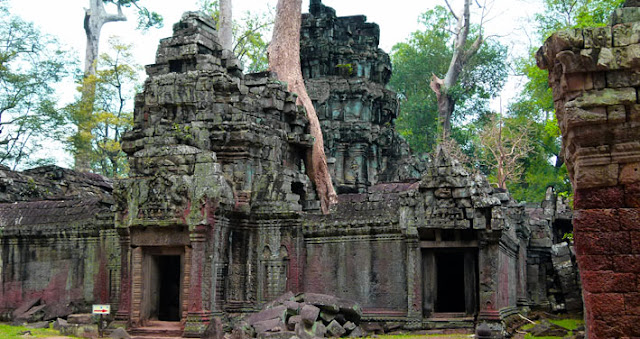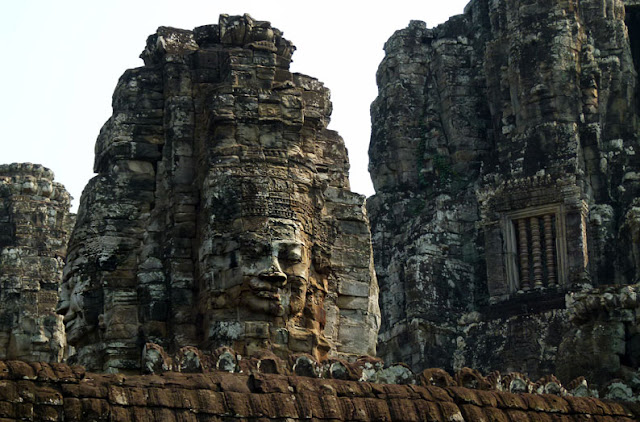In the 12th Century Angkor Thom was built
The main and most impressive structure at Angkor Thom is the Bayon temple. It was built at a time when religious symbolism played an increasingly visible role as it is shown with the mysterious smiles at the face towers when Angkor Thom was built in this ancient brick style. King Jayavarman VII (reigned 1180-1217) a staunch Buddhist, was convinced to be a Bodhisattva the faces might have been created after his model. Jayavarman VII began building Angkor Thom in 1200 over the old city of Udaydityavarman II centered on his Baphuon.
King Jayavarman VII (reigned 1180-1217) a staunch Buddhist, was convinced to be a Bodhisattva the faces might have been created after his model. Jayavarman VII began building Angkor Thom in 1200 over the old city of Udaydityavarman II centered on his Baphuon. He surrounded it with a gigantic moat at least a hundred meters wide and 15km long. It became the focus of a final, huge complex of canals and irrigation, with extra barays.
A wall was built around with five gates marked by huge gate-pavilions were constructed.
Here are pictures of Angkor Thom and Angkor Wat
The four gates were at the cardinal points, and the fifth gate in the east wall was there to keep the old road open which links the Phimeanakas to Ta Keo, which lay slightly to the north of the east-west center line.
Zhou Daguan a Chinese diplomat who visited Angkor Wat in 1296 – 1297 wrote that the faces
could also be a Buddha image. The face towers or Bayon faces are probably some of the most impressive structures at Angkor Thom Cambodia.
Along the causeway statues of demons and gods are placed, having the bodies of Nagas (mythical snakes). These scenes thought to have some connection with the Rainbow Bridge in Hindu mythology which connects the humans with the gods.
The demons move from the right side of the city gates against the gods at the other side.The main structure at Angkor Thom is the Bayon temple which is today more or less only an assembly of ruins, some are leftovers with Buddhist background and others with a Hindu destination.
Here is an ideal Asian culture holiday destination for people who are also interested in education, similar to all other shrines, palaces, and buildings in the area. When walking through this temple precinct restoration attempts can often be watched. This is going on and is financed from different countries among them Germany and India because tourism and holidays are the new business now some trees stopped growing over Angkor Thom.
Here is a prime travel destination of ASEAN and there are only very few countries with such a rich cultural background that are Cambodia, Myanmar / Bagan and a few spots in Thailand such as Ayutthaya and Sukhothai, in Indonesia, it’s mainly Borobudur and the Hindu Temples of Bali.
Every day trip to Angkor Thom starts in Siem Reap where all facilities are including hotels, shopping, and nightlife.
At that time Khmer Religion religion was a blend of Buddhism and Hinduism which was practically the same everywhere in the region. Only much later the Islamic barbarians marched into these countries and what did they do? The first was the destroyed the faces of Buddha statues, what an achievement for primitivists and total disrespect of other cultures.
Today The Bayon temple and buildings are more or less only an assembly of ruins.
There is restoration going on financed from different countries among them Germany. The temples had continuous reconstruction over several hundred years since war and demolition were continuously coming and going. In 1177 the Chan invaded Angkor but 4 years later the troops of King Jayavarman VII recaptured the city from the Chan, today the capital is Phnom Penh.In the course of reconstruction, the king had Angkor Thom built as the new capital, in the center of the new city the Bayon was erected. The new city was enclosed by a moat of 13 km length. Five gates gave way to the city, each one placed at the four cardinal points and the fifth led directly to the King's palace.
The access road through the south gate is flanked by nine headed Nagas (mythical snakes) and 54 Asuras (demons) are holding them at the right side and on the left side are 54 Devas (gods) holding them. The gates are crowned with huge smiling stone faces.
The gates are large enough for elephants to pass and today vans cross through. Every gate has a similar size and is flanked by mythical figures. The Bayon has been erected in the center, this was the first State Buddhist temple. The Bayon bas-relief temple wall was originally only a one terrace structure and was later increased to three terraces. Since the fortifications were built very well this old city was also used as capital in the subsequent generations, rather than building new temples this one was rebuilt and renovated again and again. This also explained the confusing architecture of corridors and rooms.
The Face Towers
The face towers are probably the most impressive views at the Bayon, from the originally 49 towers still 37th stand.
At almost all of the faces looking to the four cardinal points. The Bayon has also some bas-relief galleries. They are part of the original temple buildings and commemorate the defeat of the Chan and also show some everyday scenes.
The inner gallery was built later and shows episodes from Hindu mythology. It reminds very much to the relief depicting Buddhist Jataka stories at Bagan Myanmar, the relief here is only substantial bigger.
Visiting the eastern gallery of the Bayon temple
Khmer warriors are depicted as well as people who prepare to eat. At the beginning of the south gallery, the battle in the Lake is shown where the forces of King Jayavarman VII defeated the Chan.The relief on the west and north side make a rather unfinished impression. Unfortunately, the whole area is mainly a field of temple ruins only. Angkor Thom bas-reliefs deal mainly with Indian classical legend. Here again, there is evidence of the influence of Chinese pictorial conventions in some of the compositions, while numerous genre passages market scenes, hunting, quarrels have often been admired, Khmer temples often are adorned by sandstone relief not only in Angkor a good another example are the temples at Tonle Bati although they are much smaller.
But it is obvious that the sheer volume of work which the artists were compelled to get through prevented them from thoroughly thinking out their ideas or fully achieving their execution. This is an art of cursory extemporization on well-worn themes. The most impressive single works of art associated with the name of Jayavarman VII are certain single iconic stone figures from various places in the Angkor Thom complex. Most of them are the Buddhas on Nagas, the 'Leper King and the idealized 'portrait' image of the king himself.
When visiting this ruins one can feel something of the dedicated skill of the earlier sculptors in Angkor Thom, and it must have been that the masters who cut these important works were allowed the time they needed to mature them. Their fluent surfaces, deep plasticity, and squared-off conception convey a sense of ultimate tranquility and celestial calm.
The Khmer King Jayavarman VII built the temple and palace precinct Bayon in the late 12th century as a monumental structure to represent the state visually.
It seems at the Face Temples had the function to remember his folks who is the boss here and he is watching them. Some scriptures of a Chinese traveler of that time indicate that.
Today Angkor Thom is a nine square kilometer complex of ruins with Buddhist and Hindu influence and the Bayon is placed in the center of this former state capital including the city walls and the moat which also function as baray (water storage ponds).
Most tourists are impressed by the huge trees crawling over the monuments, walls, and ruins. The gate pavilions embody the outstanding the architectural invention of Jayavarman's reign, which has become almost a symbol for Angkor the tower with four colossal faces looking out in the four cardinal directions. These smiling faces on top of the tower, which in some way are related to the icon of Lokeshvara, at the same time, symbolize the power of the king, demonstrating his domination of the four quarters of the world.
 The Bayon which was Jayavarman's own sacred temple-mountain with the smiling faces is crowded with towers most of which carry the same motif him. The masks are combined with the terraced tiers of the towers, with their corner-recesses and projecting false porches, in such a way that the section becomes virtually octagonal. The elevations present both the curved and the pointed, sprouting-shoot contour.
The Bayon which was Jayavarman's own sacred temple-mountain with the smiling faces is crowded with towers most of which carry the same motif him. The masks are combined with the terraced tiers of the towers, with their corner-recesses and projecting false porches, in such a way that the section becomes virtually octagonal. The elevations present both the curved and the pointed, sprouting-shoot contour. The arches of the gateways, and within the face towers of the Bayon temple which appear somehow like smiling are triangular and corbelled. Generally speaking, the stonework is hasty and relatively ill-trimmed and was carved into its final shape and surface in situ. It reminds to Bagan Pagoda Architecture.
The arches of the gateways, and within the face towers of the Bayon temple which appear somehow like smiling are triangular and corbelled. Generally speaking, the stonework is hasty and relatively ill-trimmed and was carved into its final shape and surface in situ. It reminds to Bagan Pagoda Architecture.



Comments
Post a Comment